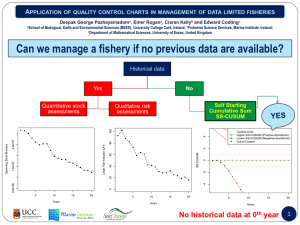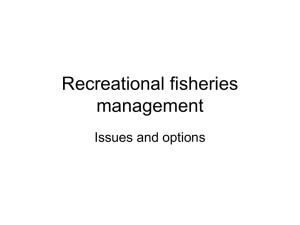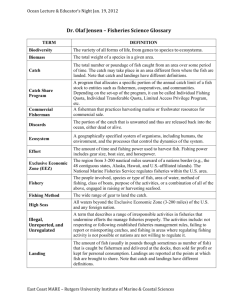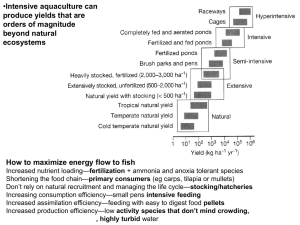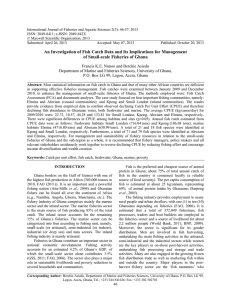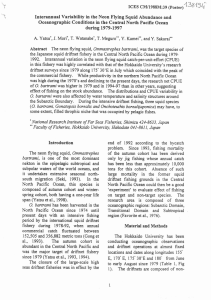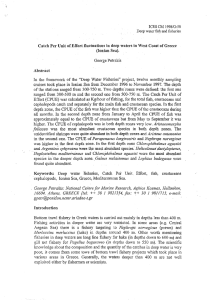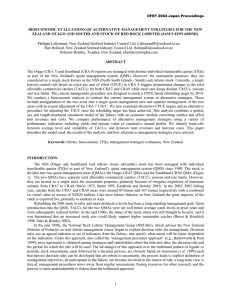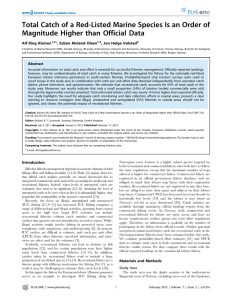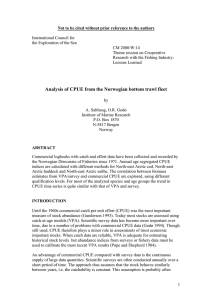FIS 507 - The Federal University of Agriculture, Abeokuta
advertisement
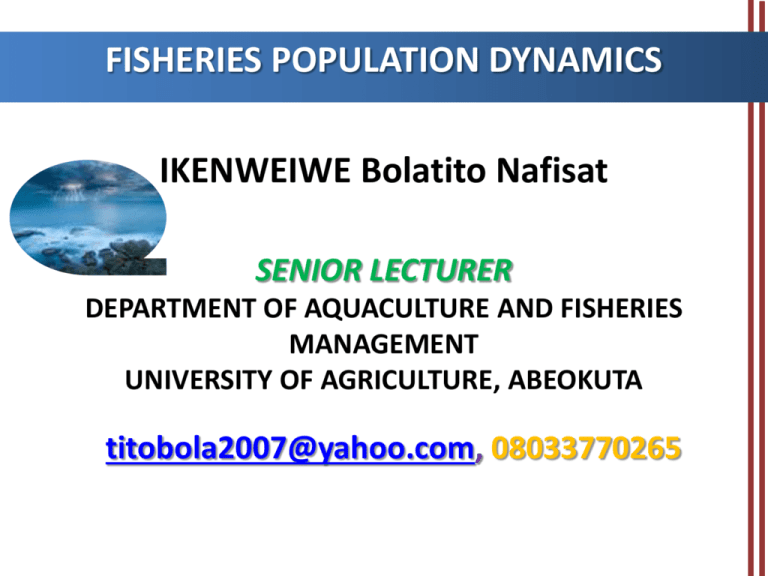
FISHERIES POPULATION DYNAMICS IKENWEIWE Bolatito Nafisat SENIOR LECTURER DEPARTMENT OF AQUACULTURE AND FISHERIES MANAGEMENT UNIVERSITY OF AGRICULTURE, ABEOKUTA titobola2007@yahoo.com, 08033770265 FISHERIES POPULATION DYNAMICS FIS 507 Catch per unit effort • Calculation for catch per unit effort for the different fishing gears • Passive Gears Gill Net Traps Longlines 3 Gill Net • Catch weight (Kg) = CPUE No. of bundles – 1 bundle = 30m by 3m – Area of 1 bundle = 90m2 – CPUE often decreases with fishing time 4 Traps • Catch = kg/trap = a No. of Trap • a x 24= CPUE per trap per day fishing hours (12hrs) • Fishing hours (set trap 7.00pm, retrieve by 7.00am = 12 hours =fishing hours) • This is applicable for all traps such Gura, bamboo and wire trap. 5 Longlines • Catch (Weight) X 12 No of lines x fishing time • This is the CPUE per line per 12 hour period which represent longline fishing day. • CPUE in this trap increase with fishing time 6 • Active fishing gears – Cast Net – Drift Net – Dragnet – Beach seine – Spears and harpoons – Trawls and dredges – Seine nets – Purse seines 7 Cast Net • Cast Net in Kg/day • Catch (weight in Kg) x 24 hours Fishing time • Assuming that total fishing hour is 24 hours. 8 Drift Net/ Beach • Catch (Kg) No. of Hauls • This gives the CPUE per haul • Since there are always ‘n’ number of hauls per day, • therefore the CPUE will equal CPUE per haul x No of hauls • CPUE decreases as number of hauls per day increases 9 • Dragnet (100m length, 6m depth of Nylon netting material of 25.5 mm stretched mesh). Beach Seine is an active fishing gear • Catch per fleet extrapolated to catch per 1000m2 of net surface area. • Area of a fleet =30m long x 3m = 90m2 • 9 mesh nets (1, 11/2, 2, 21/2, 3, 31/2, 4, 5, 7 and 9 inches) • Therefore 9 x 90m2 = 810m2 • If 810m2 gives ‘x’ weight of fish • 1m2 will give x/180 weight of fish 10 • Therefore, 1000m2 = (x/180) x 1000 weight of fish • X = 10 x 1000 • Where x = sum of all fish caught by all meshes and this is compared to the weight of fish caught by sampling boat (Kg) under commercial catch 11 Capture of Fishes and Examination of fishes • Terms – Total length is defined as the measurement taken from the anterior-most part of the fish to the end of the caudal fin rays when compressed dorsoventrally (Anderson and Gutreuter 1983). 12 – Fork length is defined as the measurement taken from the anterior-most part of the fish to the end of the median caudal fin rays (Anderson and Gutreuter 1983). – Standard length is defined as the measurement taken from the tip of the lower jaw to the posterior end of the hypural bone (Anderson and Gutreuter 1983). 13 1. Total Length 2. Fork Length 3. Standard Length 4. Head Length 5. Snout Length 6. Caudal peduncle 7. Fin Rays 8. First Dorsal 9. Second Dorsal 10. 11. 12. 13. 14. 15. Pectoral Fin Pelvic Fin Anal Fin Finlet Caudal Fin Lateral Fin 16. 17. 18. 19. Scutes Opercle Preopercle Interopercle 20. Adipose Eyelid 21. Supramaxilla 22. Premaxilla Source: http://www.texasgulfcoastfishing.com 14 External and Internal Anatomy Source:http://www.kentuckylake.com 15 Source:http://www.kentuckylake.com 16 Gill Net Setting and Randomization • Experimental gill nets with graded stretched mesh sizes 1”, 1½”, 2”, 2½”, 3”, 3½”, 4”, 5” and 7” inches • which are equivalent to 25.4, 38.1, 50.8, 63.5, 76.0, 88.5, 101.6, 126.4 and 177.2 millimeters respectively, • Should be set for fish stock assessment while monitoring simultaneously the physico-chemical parameters at each fish sampling station. • Each mesh size of the experimental gill net measuring 30 meters in length and 3 meters depth will be arranged randomly and joined together to form a fleet giving a total surface area of 810m² per fleet. • The nets will be mounted at 50 % hanging ratio. • 1” and 1½” meshes were included in the fleet in order to catch all small fish species in the water body. • Also as fishermen were currently using these meshes (1” and 1½”) to exploit the fishery, • their inclusion in the fleet would give a useful index of abundance in small mesh nets and • the relative catch per unit effort in relation to larger mesh nets Setting of the Experimental Gill Net during sampling hour of 68pm MARK- RECAPTURE • Reconnaissance visit will be paid to the lake (water body) • Gears to be use must not cause harm or injury to the fish. • Some individuals (fishes) will be captured • Caught fish will be marked/tagged and returned into the water body unharmed • Marking or tagging materials must not be harmful and must be easy to see or detect • After some days/weeks/months (depending on the type of research), a second visit will be paid to the study area • Fishes are captured for the second time and sorted into marked and unmarked • Third, fourth or more visits are can be made • Mark recapture methods rely on some sort of representative sample taken at two different times • Most commonly used mark-recapture estimate of population size is the same as the Lincoln index or Peterson Index which assumes that: • The proportion of individuals which are marked in the population is the same as the proportion of individuals which are marked in a recaptured sample. • M = N R C – M = total individual marked in the population – N = Total population size (which we don’t know but would like to) – R = Number of marked individuals which are recaptured – C = Total number of individuals (marked and unmarked) which are captured in the second trial • N = MC/R FURTHER READINGS • Ikenweiwe, N.B, D. Odulate, B. Adigun (2011) Ichthyology and Limnology: Tools In Fisheries Management Fisheries Management. United Kingdom. Lap Lambert Academic Publishing. ISBN: 978-3-8433-9364-5. Available online at http://dnb.b-nb.de 127 pages • Ikenweiwe B. and S. Otubusin (2010). Limnology and Plankton Abundance. Germany. Verlag Publisher. ISBN- 10: 3639253167, ISBN-13: 9783639253160 (Available online at http://www.researchbooks.org/3639253167/LIMNOLOGYPLANKTON-ABUNDANCE-FISH-PRODUCTION/). 249 pages. • Ita E. O. and M. Mdaihli (1997). The Current Status Of Fish Stock And Fisheries In Kainji Lake
